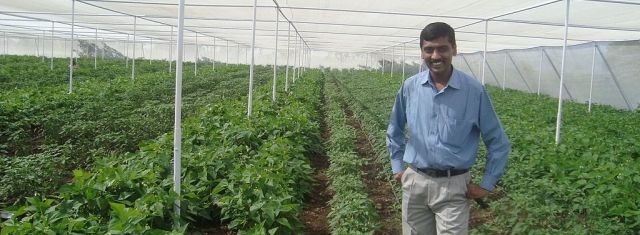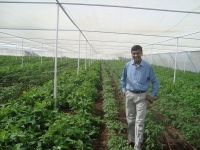Health
Sustainable agriculture: the road to hell is paved with good intentions
How sustainability can lose itself

(Source: Wikimedia Commons, Suhasajgaonkar)
The global economy is at last reorienting towards more environmentally friendly and sustainable practices. And this is particularly true in the domain of agriculture. But any ecological transition must be guided by scientific rationale. Radical breakthroughs can cause problems, especially if pursued on purely ideological grounds.
As was seen in Sri Lanka’s abrupt switch to an all-organic farming model, sudden moves can compromise the balance of long-standing economic practices, leading to food insecurity and even economic disaster. Real change cannot be enacted overnight.
When the Sri Lankan government banned chemical fertilisers, roughly two-thirds of local farmers agreed with the vision behind the policy. Unfortunately, the speed of change left few of them with time to adjust. It can take soil at least two years of transition before organic crops produce comparable yields to those of non-organic fields.
Sri Lankan agriculture was severely damaged by the short-sightedness of this well-meaning policy shift. And there is a general lesson here, one that extends to policy-setting broadly.
This is especially relevant for markets that are sophisticated in terms of health, safety, and environmental regulation. Driven by ideology and precaution, they continue to impose ever-stricter standards on themselves. This has the potential to compromise the competitiveness and security of their domestic farmers and, counterproductively, to encourage imports of products from less well-regulated markets.
Canada and neonicotinoids
The situation in Canada around the temporary ban on neonicotinoids is one example of where things can get clouded.
For good reason, environmental purists have been pushing for an end to the use of this category of insecticides. Neonicotinoids, such as clothianidin and thiamethoxam, have been under fire for their impacts on the survivability of bee colonies, which play an important role in pollination. Other insects are also impacted when such products are applied to seeds.
A series of investigations, at first, led to a precautionary ban on the use of neonicotinoids. But only minute concentrations of the chemical were subsequently found in water samples taken near fields. And these were at levels below the threshold of risk to insects.
The Pest Management Regulatory Agency then determined that “the risks to aquatic invertebrates resulting from chronic exposure following application of clothianidin […] are acceptable.” Health Canada scientists came to a similar conclusion about thiamethoxam.
The ban was dropped, while maximum limits permitted in the use of these chemicals (per kilogram of seeds) were reduced and made stricter. The resulting regulations on the use of neonicotinoids apply to a range of fruit and vegetable crops, stipulating precise, scientifically evaluated maximum volumes of these products.
The protection of bees and other insects was achieved. However, environmentalists who take a more radical position continue to demand an outright ban.
They fail to recognise that a total ban on neonicotinoids would result in damaging and unnecessary costs for farmers, likely reducing the effectiveness of their practices. The penalties on efficiency, in turn, would lead to price increases that reduce the local farmer’s competitiveness, potentially impacting their livelihoods.
They fail to recognise that a total ban on neonicotinoids would result in damaging and unnecessary costs for farmers, likely reducing the effectiveness of their practices. The penalties on efficiency, in turn, would lead to price increases that reduce the local farmer’s competitiveness, potentially impacting their livelihoods.
While environmental ideals might be understandable, all aspects of issues require proper inspection. The damage caused by a severe policy decision in this context could undermine agricultural efficiency, leading to counterproductive outcomes for the green project overall.
EU fertilisers and cadmium
Another example of this kind of radicalism exists in the discourse around limits on the levels of cadmium permitted in fertilisers in the European Union. Cadmium is a natural element that is present in our environment, mainly due to geological factors, though industrial practices have historically also been a contributor.
Cadmium is also present in certain fertilisers as a trace impurity. Cadmium poisoning can have severely negative effects on human health. While a cadmium cycle — from its application in fertilisers to plants, to its subsequent presence in food — is not scientifically established, a precautionary stance is why the EU has the strictest regulations in the world.
Currently, the levels permitted are 60mg per kilogram of fertiliser, with regulations intended to reduce this down to 20mg per kilogram of fertiliser over the next ten years. Environmentalists have been behind much of the pressure exerted on lawmakers to continue reducing cadmium limits.
It is important to note that one of the leading scientists on the subject indicates that most cadmium already present in soils comes naturally from localised alteration in bedrock. Cadmium input from phosphate fertilisers into soils is less than 0.1% per year, according to Professor Erik Smolders, an environmental chemist and researcher at KU Leuven University.
In his research, Smolders emphasises that high levels of cadmium in soils are largely attributed to localised geological factors or industrial and domestic pollution:
Most Cd [cadmium] anomalies in European agricultural soil can thus be directly related to different geogenic sources (e.g., underlying rocky subsoil, soil type, mineralisation and ore deposits) […] [A] few very small Cd [cadmium] anomalies can be attributed to anthropogenic sources, such as urbanisation and fertilizer use.
(Smolders et al. 2020)
Most Cd [cadmium] anomalies in European agricultural soil can thus be directly related to different geogenic sources (e.g., underlying rocky subsoil, soil type, mineralisation and ore deposits) […] [A] few very small Cd [cadmium] anomalies can be attributed to anthropogenic sources, such as urbanisation and fertilizer use.
(Smolders et al. 2020)
Scientific consensus indicates that an average of 73mg per kilogram of fertiliser would be sufficient to protect the population from toxicity. Furthermore, due to the marginal impact of fertilisers on cadmium levels in soils and plants, cadmium limits lower than the current 60mg per kilogram would have no significant positive impact on the issue.
Frequently called upon by the European authorities, Smolders asserts that, in a medium scenario, cadmium concentrations in European soils will decrease by 15% over the next 100 years — without any cadmium limits in place at all.
Restrictive limits do, however, have other fallouts.
First and foremost, strict limits reduce the number of viable fertiliser suppliers to the EU. Because cadmium levels in phosphate are a geologically determined quirk, fertilisers from different regions have different levels of cadmium present. Excessive limitations, therefore, prevent some of the world’s largest producers of fertilisers from supplying the EU market. This can create artificial limits on supply, raising market prices. Invariably, farmers will pay the price. But just as importantly, these kinds of pressure can put farmers out of business. And any holes in food supply are filled by imports, creating a greater carbon footprint.
First and foremost, strict limits reduce the number of viable fertiliser suppliers to the EU. Because cadmium levels in phosphate are a geologically determined quirk, fertilisers from different regions have different levels of cadmium present. Excessive limitations, therefore, prevent some of the world’s largest producers of fertilisers from supplying the EU market. This can create artificial limits on supply, raising market prices. Invariably, farmers will pay the price. But just as importantly, these kinds of pressure can put farmers out of business. And any holes in food supply are filled by imports, creating a greater carbon footprint.
Again, the reason this policy is likely to be met with frustration is that there would be no meaningful impact on cadmium levels in soils over time as a result. The superfluous restrictions will, however, increase imports of products from less well-regulated markets. This leads us to another irony of the controversy: products in which high levels of cadmium are most often present are, in fact, imports. Cocoa powder is one such example.
While cadmium is dangerous, the current EU policy limit of 60mg per kilogram of fertiliser is more than sufficient, according to experts on the subject — and going beyond this has no benefits. A pan-European study, published in 2014, already concluded that less than 1% of 1600 people tested were at any risk of exceeding cadmium exposure recommendations.
Stricter policy will, however, harm EU farmers and consumers. This is a glaring example of where calls for revolutionary policy change create unnecessary problems, while well-considered reform, though less galvanising — finds a sound balance. The EU is particularly vulnerable to the consequences of this type of regulatory overstep on environmental issues. Because of its positioning as the vanguard of environmental efforts, EU lawmakers are sensitive to voices that bring its green prestige into question.
Rational distinction is essential
While many people believe that society must tread extremely carefully around genetically modified crops, for reasons that have garnered considerable debate — it is irrational to extend this distrust to sophisticated crosses of naturally occurring varietals. This is just one more example of when ideology is doing too much of the thinking for us.
In such scenarios, ideological grandstanding offers little utility, and is oftentimes counterproductive. Hopefully, going forward we can make the necessary distinctions, even when subjects have become emotionally conflated by ideological discourse.
Liability for this article lies with the author, who also holds the copyright. Editorial content from USPA may be quoted on other websites as long as the quote comprises no more than 5% of the entire text, is marked as such and the source is named (via hyperlink).






